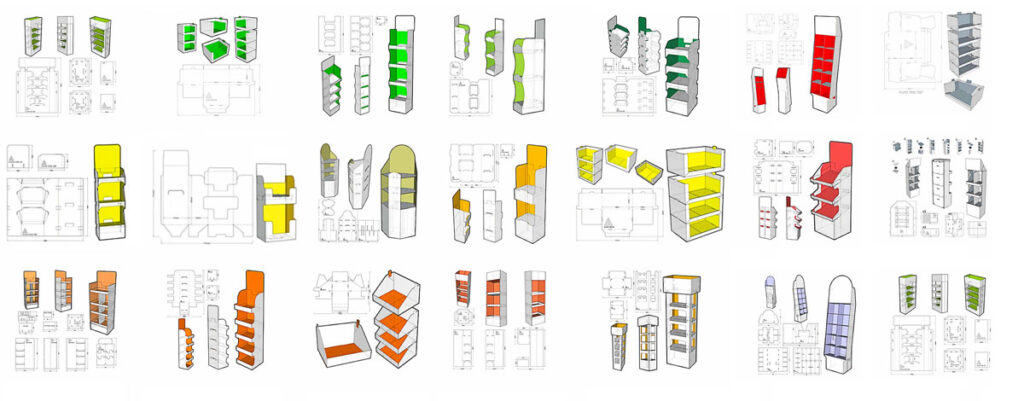In today’s digital-first world, where screens dominate our daily lives, it’s easy to assume that traditional marketing methods like cardboard displays are becoming obsolete. However, contrary to this assumption, cardboard displays are not just surviving—they are thriving. As digital platforms continue to evolve, the role of physical marketing materials, especially cardboard displays, is becoming increasingly important. In this blog post, we’ll explore why cardboard displays will continue to be relevant in the future and how they can adapt to meet the demands of an ever-changing retail landscape.
The Resurgence of Tangible Experiences
In the digital era, consumers are bombarded with online ads, pop-ups, and digital content at every turn. While this vast digital landscape offers convenience and speed, it often lacks the tactile, sensory experience that physical displays can offer. The rise of consumer fatigue from digital overstimulation is pushing brands to bring back tactile marketing tools that engage customers in a more immersive, hands-on way.
Cardboard displays, with their vibrant designs and physical presence, provide an opportunity for brands to create a tangible experience that connects with consumers on a deeper, emotional level. When strategically placed in stores or at events, they invite customers to interact, touch, and even smell (think: scent-infused displays), which are senses that digital marketing simply can’t replicate.
The Rise of Omnichannel Marketing
The future of retail is omnichannel—where online and offline experiences are seamlessly integrated. This shift means that brands will need to blend the power of digital marketing with physical marketing techniques. Cardboard displays play a pivotal role in this strategy. They can direct customers to an online store, encourage social media engagement, or even feature QR codes that lead to promotional content or discounts.
Imagine a retail display that not only showcases a product but also includes a digital element, such as an interactive screen or an augmented reality (AR) experience. This blend of physical and digital is the future of cardboard displays. They can bridge the gap between in-store shopping and online experiences, providing a hybrid solution that appeals to a tech-savvy audience while maintaining the tactile qualities that make them so effective in physical retail spaces.
Sustainability and Eco-Friendly Trends
As sustainability continues to be a driving force in both consumer behavior and manufacturing practices, cardboard displays are perfectly positioned to benefit. Made from recyclable materials, cardboard displays are an eco-friendly alternative to many other display options. Consumers are increasingly favoring brands that are environmentally conscious, and using sustainable materials like corrugated cardboard not only aligns with these values but also improves a brand’s image in the eyes of eco-aware consumers.
In the future, we can expect to see even more innovations in sustainable cardboard displays. For example, displays that are entirely compostable or made from recycled paper products are already being explored. Additionally, technologies that enable on-demand printing and customizations will allow brands to create displays that are more personalized, more cost-effective, and less wasteful.
Customization and Personalization
One of the key advantages of cardboard displays is their versatility. They can be easily customized to fit any brand’s aesthetic, product type, or seasonal campaign. In the future, the ability to create personalized and highly specific displays will be even more accessible. Advances in digital printing technology, for example, will make it easier to produce smaller runs of bespoke displays that can cater to a niche market or a specific demographic.
Furthermore, as data collection becomes more sophisticated, brands will be able to create displays that target specific customer segments. Cardboard displays could incorporate dynamic elements like interactive touchscreens, sensors, or even AI that tailors the content based on who is interacting with the display. This level of personalization will be a game-changer in physical retail, helping brands to create truly immersive and relevant experiences for their customers.
The Integration of Technology: AR, VR, and Beyond
One of the most exciting possibilities for cardboard displays in the digital-first world is their integration with cutting-edge technologies like Augmented Reality (AR) and Virtual Reality (VR). Imagine walking into a store and scanning a cardboard display with your phone to unlock an AR experience that allows you to see the product in your own home before purchasing it. This seamless integration of physical and digital will enhance the customer experience and drive higher engagement rates.
Virtual Reality could also bring new possibilities for cardboard displays in experiential marketing campaigns. For example, a cardboard display could serve as the entry point to a VR world where consumers can immerse themselves in a brand story or product demonstration. The potential for combining traditional display materials with modern technology is vast, and it will continue to redefine what’s possible in retail marketing.
The Role of Cardboard Displays in Experiential Marketing
Experiential marketing—the practice of creating immersive, hands-on experiences for consumers—is on the rise, and cardboard displays are perfectly suited for this trend. Whether it’s a pop-up shop, an in-store installation, or a branded event, cardboard displays can be used to create memorable experiences that resonate with customers.
The future will see more brands incorporating cardboard displays into interactive installations that allow consumers to engage with the brand in fun, innovative ways. With the right design, cardboard displays can be used as storytelling tools, guiding customers through a journey that connects them to the brand’s values, mission, and products.
Conclusion: The Enduring Relevance of Cardboard Displays
In a world that’s increasingly dominated by digital interactions, it might seem that traditional tools like cardboard displays would fade into obscurity. However, as this blog has explored, the future of cardboard displays is bright. They’re evolving to meet the demands of an omnichannel, tech-savvy, and eco-conscious world.
By blending physical and digital elements, embracing sustainability, and offering customization options, cardboard displays are positioning themselves as a key tool in the future of retail marketing. Whether used to engage customers in-store or enhance online experiences, cardboard displays will continue to play a crucial role in the marketing strategies of tomorrow.
As we look ahead, the future of cardboard displays is not about replacement; it’s about evolution. They are adapting to the digital-first world, ensuring they remain a relevant, powerful, and sustainable marketing tool for years to come.


